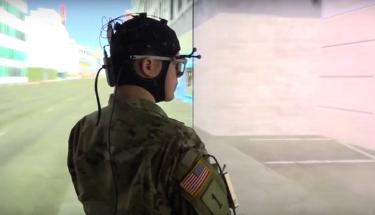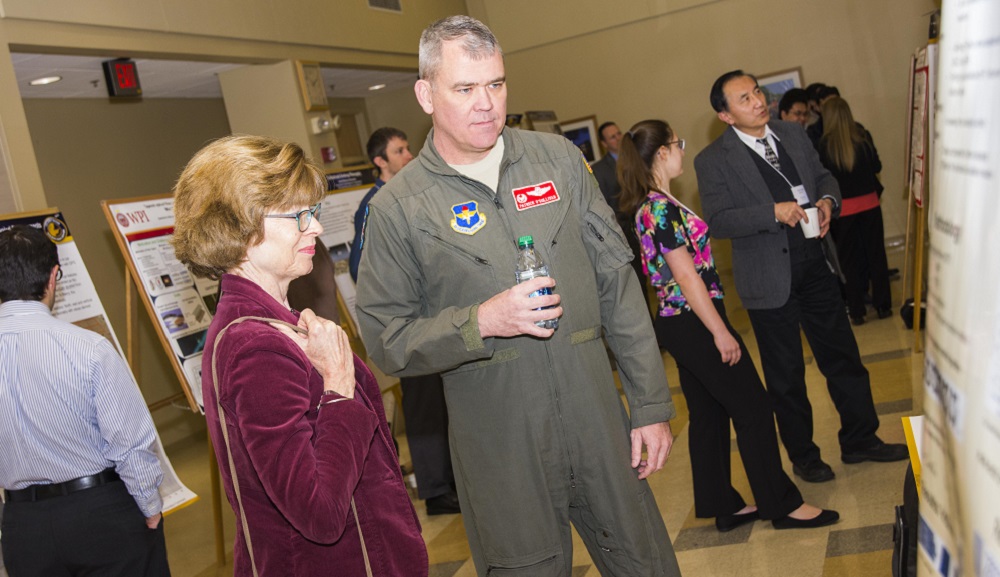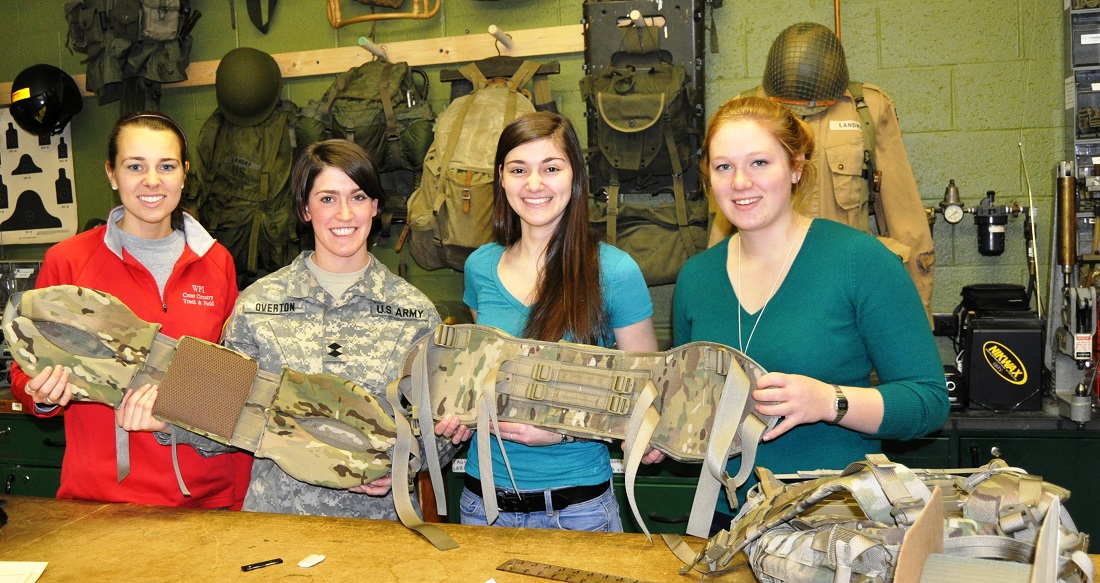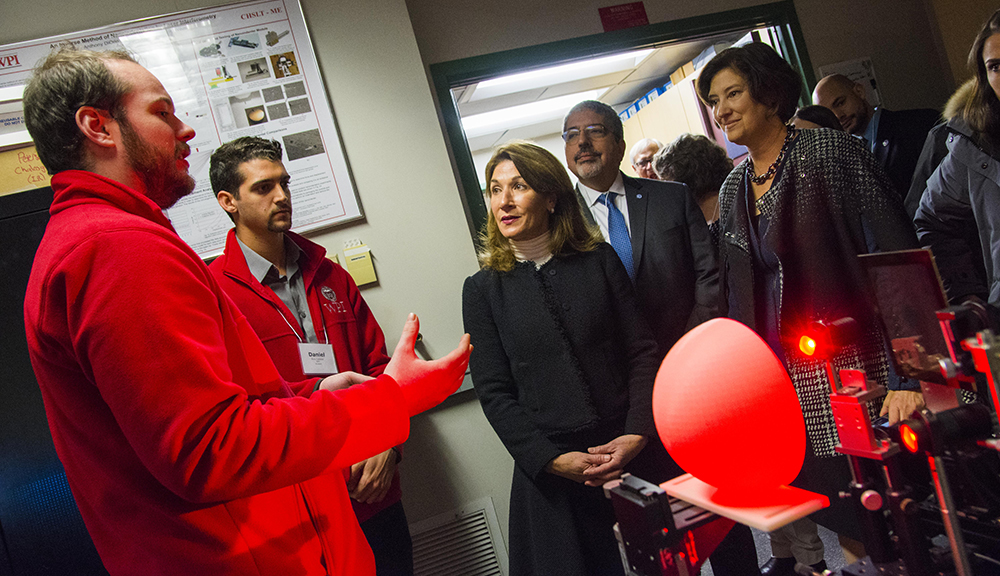On Monday, February 26, WPI will host a Soldier Science Research Symposium, which will include presenters from both WPI and the U.S. Army Natick Soldier Research, Development, and Engineering Center (NSRDEC). The goal of the symposium is to help researchers from both institutions identify potential collaborative projects that can make soldiers’ lives easier, healthier, and safer.
WPI and NSRDEC—commonly called Natick Labs—are similarly focused on finding solutions to problems, but the symposium brings researchers from both institutions together in a new way to highlight the benefits of a continued relationship where expertise, facilities, and equipment are shared. The NSRDEC is responsible for almost everything that has to do with a soldier’s needs in the field including living quarters, protection, food and nutrition, clothing, and equipment.
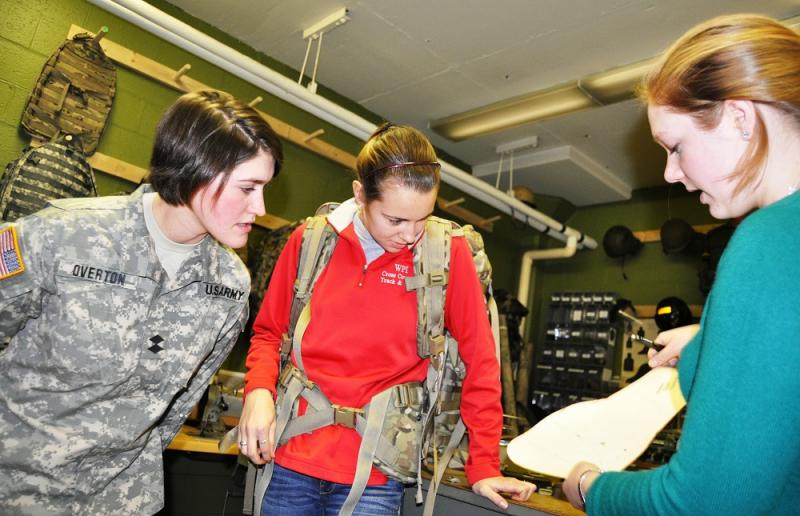
Army ROTC Cadet Marlisa Overton ’14, Amy Babeu ‘14,
and Rachael Matty ’14 worked with Natick Labs
researchers to create a prototype female-friendly
rucksack hip belt.
“We have worked with NSRDEC for decades,” says Bogdan Vernescu, vice provost for research. “It was usually one-on-one with researchers; we want to build and expand on this collaboration by bringing institutional support for connecting our research in science and engineering to solutions addressing soldiers’ needs. The symposium will bring together researchers on both sides, some who have collaborated in the past and many who will find exciting problems to collaborate on in the future.”
WPI and NSRDEC approach research in different ways, so bringing both sides together is especially beneficial. “At WPI, we are thinking of research projects and the impact they can have,” says Karen Troy, associate professor of biomedical engineering. “We are more capability driven. For NSRDEC, their projects are generally needs driven because they have a problem they want to solve.”
The symposium will include poster presentations by WPI and NSRDEC, with expected totals of approximately 30 to 40 on each side. “We are trying to find out what we have not thought about,” says Vernescu. “It’s always exciting to bring in people from different disciplines and backgrounds to brainstorm on solutions for real-world problems.”
The symposium will help find connections between WPI’s capabilities and NSRDEC’s needs. WPI’s poster topics encompass many disciplines. A few examples include research in using sensors to prevent pressure ulcers, multi-robot missions, additive manufacturing processes, optical use tweezers, and even a load-limiting shoe to reduce injuries. NSRDEC topics include novel drying technology for footprint reduction and nutrient retention of compressed military ration components, human augmentation through the use of exoskeleton technologies, multifunctional surface science at NSRDEC, and novel infrared passive and active optoelectronic films and fibers.
WPI’s specialties address NSRDEC’s needs well, which are shown in the In Great Company video. WPI has offered cohort degree programs (MS in systems engineering and MS in materials science) at NSRDEC for many years. This exchange helps educate NSRDEC employees while the collaborative research strengthens the talent pipeline from WPI. The connections are so strong that approximately 50 WPI alums work at the facility.
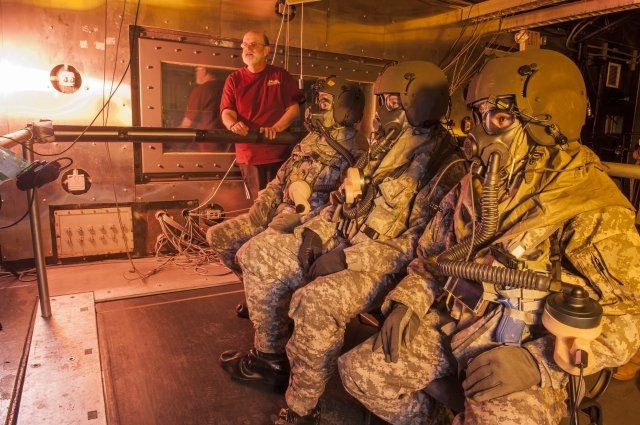
WPI worked with the Army in testing the Light-Weight
Environmental Control System, a body-worn cooling
system that allows air crew members to move around
inside the aircraft without being tethered and to exit the
aircraft while still being cooled.
"WPI provides unique technical expertise and facilities that fill gaps in the NSRDEC's core competencies,” says Jennifer Rego, research chemist at NSRDEC. “Leveraging WPI's world-class faculty and highly motivated students enables the NSRDEC to fulfill its mission to provide the Army with innovative science and technology solutions for optimizing the performance of our soldiers." Projects, she says, can lead to everything from better ear and eye protection, to new methods to process and prepare combat rations, to unmanned aerial vehicles that deliver supplies.
According to David Accetta, chief of public affairs at NSRDEC, the two main focus areas for NSRDEC are performance optimization and soldier lethality, both of which lead to improved combat readiness and therefore are an advantage over adversaries and increased survivability for troops.
Students reap benefits from the relationship as well. Megan Mancuso, a WPI PhD student in biomedical engineering, completed an internship in which she worked with both the NSRDEC and U.S. Army Research Institute of Environmental Medicine (USARIEM). The research, “Quantifying Subject-Specific Tibia Loading During Soldier Activities,” helped determine how to reduce stress fractures in soldiers’ extremities, a common injury in the field.
Mancuso found just working with others who had a different approach helped move her own project forward. “I was able to experience a different research culture,” she says. “I was used to the academic structure that’s project driven. In the Army, there were more people working on a similar project and who had research interests similar to mine. They also had a different hierarchical structure and their research is more mission driven.”
For Troy, working with NSRDEC is personally and professionally rewarding. “Soldiers do a very difficult job,” she says. “If my research can make things easier so they can do their job better and make them safer, that’s a good outcome for me. And, many of the research findings are useful and beneficial to people outside military settings.”
- By Julia Quinn-Szcesuil
